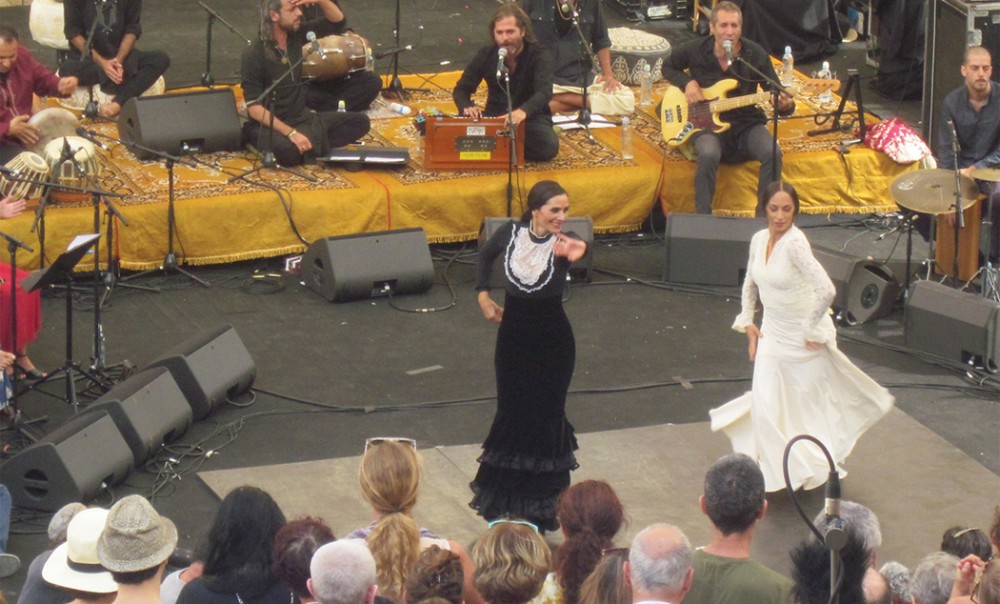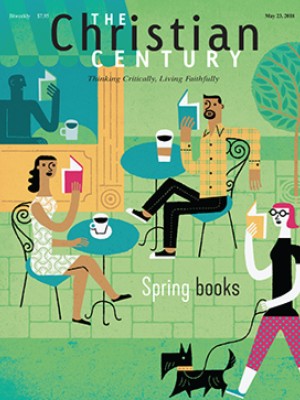The sacred work of Jerusalem's Mekudeshet festival
When Jews, Christians, and Muslims gather to celebrate arts and culture, the dividing walls crumble.

Though Jerusalem’s 800,000-odd citizens are squeezed into a relatively small space, people of different religious, ethnic, and national traditions tend to live in separate enclaves and rarely interact at more than a superficial level. Orthodox Jews, secular Jews, haredi (or ultraOrthodox) Jews, Arab Christians, and Arab Muslims may see each other in the street, line up for the same bus or train, and shop in the same malls, but their interactions are usually that limited. The city which in the words of Psalm 122 is “bound firmly together” is anything but.
In 2016, an independent group of Jerusalemites decided to celebrate and explore the city’s diversity with a festival of arts and culture. Called Mekudeshet (derived from the Hebrew word for sacred), the group organized a variety of activities, including an event in Gai Ben Hinnom, the valley known as Gehenna in the English Bible and familiar to Bible readers as the place where children were sacrificed to the god Moloch.
Read our latest issue or browse back issues.
An assorted group of Christians, Jews, and Muslims gathered around a young Catholic priest, who taught the assembly to sing songs in Hebrew taken from the book of Psalms. Alongside Protestant and Catholic clergy was a group of Coptic priests for whom this was their first encounter with the world outside the Old City of Jerusalem, where they reside. They were thrilled at the opportunity to meet other kinds of Christians and even non-Christians.
In 2017 the Mekudeshet staff organized encounters that shed light on different aspects of the city. The first event was a meeting with Ziad Jadallah in Zur Bachar, an Arab village incorporated into the Jerusalem municipality after the 1967 war. Ziad commented that “there are many walls inside the city,” invisible walls that prevent residents from fully participating in the life of the city.
For example, Ziad said, Magen David Adom, the Israeli equivalent of the Red Cross, did not operate in Zur Bachar or other parts of East Jerusalem. This meant that the 330,000 Arab residents of East Jerusalem were without access to emergency medical help. Training for MDA volunteers was offered—but only on the west side of the city. “I registered, and was the only Arab in the course.”
After completing the course, Ziad was able to open a branch of MDA in Zur Bachar, and he then began training Arab youths to join the service.
“I started with 30 youngsters. Since they don’t learn Hebrew in school, I sent them to a Hebrew course in West Jerusalem. Simultaneously, Israelis working in the service were taught Arabic.
“Importantly, I taught each group of young people to change their attitude. I taught them what an ambulance is for—not as target practice for their stones, which is how they used them during the intifada. They learned how to work with others and for others. Since they know Hebrew as well as Arabic, they can work on both sides of the city.”
The creation of the MDA branch opened the way to further constructive developments in the area. Ziad spoke to the Mekudeshet participants inside a new community center that he helped to establish. It’s the first of its kind on the east side of the city and offers activities for youth.
Leaving Zur Bachar, Mekudeshet organizers led people into the Jewish Quarter of the Old City. With its Jewish, Muslim, Christian, and Armenian sectors, the Old City represents the way neighbors in Jerusalem are often walled off from each other.
But in the house of Hannah Sperber, that picture changes abruptly. Chanah and her husband, Rabbi Daniel Sperber, are Orthodox Jews, living in a large house whose foundations were laid in the 19th century. Their house had to be large for their ten children and their massive library.
“We brought up our children in as open a way as possible,” explained Hannah. The couple invited Christians and Muslims into the house so the children could encounter a wide variety of people. “What we taught them was that they could keep their own identity and values stemming from their own tradition and simultaneously mix with anyone.”
One of their daughters, Esther, helped found a modern Orthodox synagogue in southern Jerusalem. Another, Abigail, is a lesbian who has established a school in Tel Aviv for both religious and secular children of lesbians and homosexuals.
Hannah proudly shows photos of her extended family, which includes some marriages between Jews and non-Jews. She is optimistic that more and more people are accepting of the “other,” which changes the nature of society. “We are more like an orchestra, in which separate instruments combine to create a united sound.”
Another stop in the Old City was at the Lutheran Church of the Redeemer in the Christian Quarter. There we met Melanie Mordhorst-Mayer, a German pastor, who told us about her own spiritual journey, speaking to us in perfect modern Hebrew.
As a theology student in Germany, she had come to Israel to study biblical Hebrew and fell in love with the land and the language. “As I studied I realized how much Christianity was influenced by Judaism, enough to say that we Christians are a sect of Judaism. Jesus was a Jew and he wanted a reformation inside Judaism.”
To improve her Hebrew, Mordhorst-Mayer lived with three Jewish women. “One of my flatmates was haredi, a second was completely secular, and the third was somewhere in the middle.” As it happened, all three were confined to wheelchairs. “It was very interesting to see the city through the eyes of the community of people with paralysis.”
As part of her studies, she became interested in some rabbinic texts which were difficult to decipher. She eventually found an ultra-Orthodox rabbi who was willing to help her. She’s now the head of a yearlong course for German theology students studying in Israel. “I stress the importance of being in a dialogue with the Jewish people. Not just as Christians, and because of what we did to the Jews, but even more so as Germans and the dreadful history that lies between us.”
She concluded her talk by inviting the assembled group of mainly secular Israelis to sing along with her in Hebrew. “It’s very important that we sing together,” she said. The group sang verses from Psalm 133: “Behold it is good and pleasant to sit together as brothers.”
Finally, the group walked to the local market of Machane Yehuda (literally “camp of Judah”) to meet Zaki Djemal. Amid the fruit and vegetable stalls, the pots and pans and assorted household items for sale, with the vendors shouting their wares for all to hear, there was a space reserved for coffee and old-style gaming tables.
Djemal, who has a Syrian father and an English mother, spoke of how Jews and Arabs have certain things in common, particularly games. After he graduated from Harvard with a degree in economics, Djemal returned to Israel and set about organizing teams to play each other in shesh besh (a local board game like backgammon) and then in football.
“It was an instant success,” he said. “We created a league. Our teams of Jews and Arabs play together and thus get to know each other. . . . It can be done.”
These efforts at interaction and communication across the walls of division are a small but significant part of life in Jerusalem. There are people in the city who appreciate diversity and are inviting people to come out of their everyday isolation. The Mekudeshet team, funded by private foundations, works year-round to bring their dream of the city to fruition. This is sacred work, as the name suggests. It is work that renews the hope that Jerusalem will be a city which truly can be called “a house of prayer for all peoples” (Isa. 56:7).
A version of this article, which was edited on May 23 to correct Djemal's paternal country of origin, appears in the print edition under the title “Holy, diverse city.”





